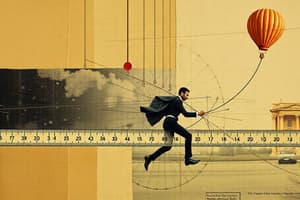Podcast
Questions and Answers
What is the importance of considering the ends of the wire when measuring its length using a rule?
What is the importance of considering the ends of the wire when measuring its length using a rule?
- To accurately judge where the wire begins and ends (correct)
- To measure the diameter of the wire
- To calculate the average length of the wire
- To ensure the wire is not bent
What is a potential source of inaccuracy when using a rule to measure length?
What is a potential source of inaccuracy when using a rule to measure length?
- The width of the marks on the rule
- The material of the rule
- The length of the rule
- The calibration of the rule (correct)
Why is it important to think critically about the measurements you make?
Why is it important to think critically about the measurements you make?
- To ensure the measurement is accurate
- To ensure the measurement is precise
- To consider the method and instrument used (correct)
- To calculate the average of multiple measurements
What is a recommended technique for measuring a small length, such as the thickness of a wire?
What is a recommended technique for measuring a small length, such as the thickness of a wire?
What is the significance of aligning one end of the wire with the zero of the scale on the rule?
What is the significance of aligning one end of the wire with the zero of the scale on the rule?
What is the purpose of dividing the measured thickness of a stack of 500 sheets by 500?
What is the purpose of dividing the measured thickness of a stack of 500 sheets by 500?
What is the advantage of using a thread to measure the length of a curved line?
What is the advantage of using a thread to measure the length of a curved line?
When measuring the volume of a liquid using a measuring cylinder, why is it important to read the scale horizontally?
When measuring the volume of a liquid using a measuring cylinder, why is it important to read the scale horizontally?
What is the purpose of partially filling a measuring cylinder with water before measuring the volume of an irregularly shaped object?
What is the purpose of partially filling a measuring cylinder with water before measuring the volume of an irregularly shaped object?
Why is it important to choose a measuring cylinder that is about three or four times larger than the object?
Why is it important to choose a measuring cylinder that is about three or four times larger than the object?
Flashcards are hidden until you start studying
Study Notes
Measuring Length
- In physics, measurements of various lengths are made, such as the length of a wire, height of liquid, distance moved by an object, and more.
- In the laboratory, lengths are often measured using a rule, such as a meter rule.
- When using a rule, it's essential to consider the reliability of the measurements, taking into account the wire's straightness, cut ends, and the rule's markings.
Factors Affecting Measurement Accuracy
- The width of the markings on the rule can make it difficult to judge the exact measurement.
- The rule's calibration accuracy can also affect the measurement's precision.
Alternative Measurement Techniques
- For small lengths, measuring multiple thicknesses and calculating the average can provide a more accurate result.
- Measuring a large number of thin objects, such as sheets of paper, and dividing by the number of objects can also provide a more accurate result.
- For curved lines, laying a thread along the line and measuring its length can be an effective technique.
Measuring Volume
- There are two approaches to measuring volumes: one for regular shapes and one for irregular shapes.
- For regular shapes, measure the lengths of the sides and multiply them together.
- For liquids, measuring cylinders can be used, and the choice of cylinder depends on the volume to be measured.
- For irregular shapes, measuring volume by displacement can be used, where the object is immersed in water, and the volume of the displaced water is measured.
Measuring Volume by Displacement
- Select a measuring cylinder that is about three or four times larger than the object.
- Partially fill the cylinder with water, enough to cover the object.
- Note the initial volume of the water.
- Immerse the object in the water, and the level of water will increase, allowing the volume of the object to be calculated.
Studying That Suits You
Use AI to generate personalized quizzes and flashcards to suit your learning preferences.




